When choosing a platform to build your small business website, your choices these days come down to two choices: drag and drop platforms like Squarespace or a robust DIY service like WordPress. While it can be tempting to go with the choice that has a smaller learning curve, Squarespace and other services like it has more cons than pros when it comes to running your small business website.
If you need a website to host your resume or portfolio, Squarespace is perfect. It's cheap, easy to set up, and requires no knowledge of programming. It also has limited functionality, storage space, sites take longer to load, and customization is next to impossible.
A website for a thriving business, or one that wants to be thriving, should be built with WordPress. Here's why.
Featured Reading: Why WordPress?

Squarespace's drag-and-drop functionality doesn't work well if you're looking to add in lots and lots of content. You'll end up with extra-long pages and your visitors will never make it to the bottom or you will struggle to organize the content in a user-friendly manner.
WordPress is like a blank canvas for your website. There are no pre-made buckets or boxes for you to try and fit your content in. The WordPress engine is also more than capable of running a large website with few hiccups.
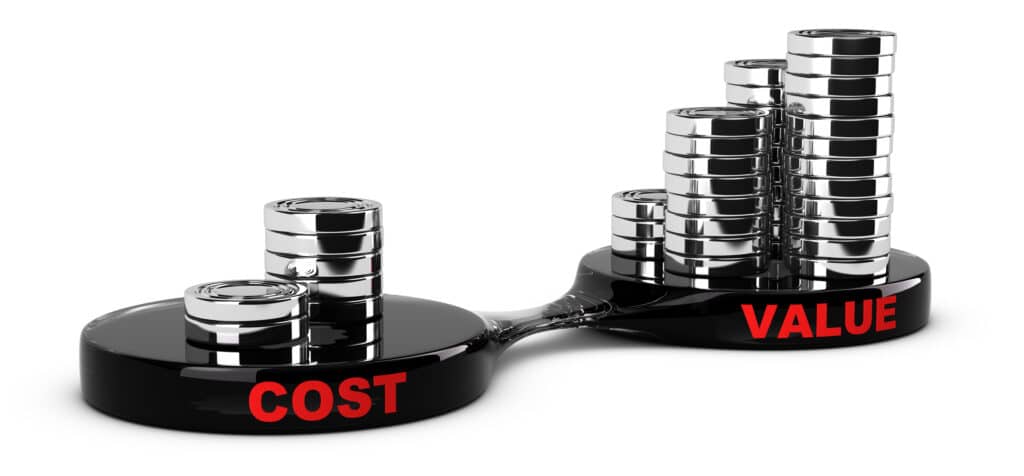
While Squarespace is one of the more affordable drag-and-drop options available with a handful of pricing plans, it's hard to beat the price of WordPress: free. It is hard to get a website live without additional services, such as web hosting, and those will cost some money. However, there are so many options for WordPress add-ons and a hosting service or a hosting plan that you can pick and choose to find one that fits your budget.

It may be tempting to dive into eCommerce with the built-in features readily available on Squarespace, but you'll quickly outgrow their capabilities, especially if you have many products. While you do have to install an eCommerce plugin, WordPress gives you a more robust suite of eCommerce tools that help you and your customers have a smooth and easy checkout experience.

Squarespace has a number of high-quality tools built into its system. It's pretty hard to beat the thousands of plugins and apps available in the WordPress community. Anything you can think of, someone has probably already created a third-party plugin for your website that could make your dream a reality.
That said, you do not want to add too many plugins to your WordPress website. Too many plugins will slow down your website's speed which can have a negative impact on your SEO efforts and turn off your visitors.

When you want to connect with your audience or keep a running portfolio of your work, a blog is a great option to have. It's also good for boosting your site's SEO. This is what WordPress was built for. Literally.
Every WordPress site includes commenting abilities, plus helpful plugins to achieve creative, content-heavy blogs. Squarespace has solid, built-in blogging tools, but it just can’t beat WordPress in this area.
WordPress detractors will point out that WordPress sites account for an outsized portion of hacked websites. While WordPress security is of the weak points of the WordPress community, one reason for this statistic is simply the sheer number of WordPress websites on the internet.
You can also combat this weakness by choosing a solid hosting provider that includes comprehensive security solutions in your hosting plan.
Featured Reading: What You Need to Know About WordPress Security
As a WordPress design firm, we may not be coming from an unbiased point of view, but that's only because we've been in this industry for decades and have been around the block with website foundations. At Thrive Design, we chose to specialize in WordPress because we think it's the best option around for small- and medium-sized businesses.
There are lots of technical things about websites that business owners don't need to worry about because they don't affect their day-to-day operations. But one thing that you should at least have a passing knowledge about is web crawlers.
Why?
Because web crawlers and the crawling process are key to ensuring that your website is turning up in any search query that is related to your business.

The short answer is this: web crawlers, also known as search engine bots, are how search engines know what content is on the internet, what it's about, and when to show it in their results. They gather information from the billions of web pages and organize it in search indexes so it can be displayed when users search for it.
If you think of the internet as the world's biggest library, web crawlers are the librarians that catalog and organize the information with major search engines acting as the card catalog. To do this, the search engine crawlers spend their time crawling the internet to determine what amounts to the title, summary, and a selection of text to figure out what the web page is about and how to properly file that information.

Because the internet is constantly changing and expanding, there is no way for any search engine to have a fully complete and accurate database of the entire internet at any point in time. Therefore, the policy they usually work with is to have their web crawlers constantly looking for new content to index. This is how they do that.
The first step for all web crawlers is to find pages that have changed or new pages that have been created. The crawlers do this by recrawling pages they're familiar with to look for new links and new content. This is why interlinking is so important for great search engine optimization.
The other way that web crawlers find new sites to index is when site owners, like yourself, ask the search engines to crawl their URL by submitting a sitemap. Your Google Search Console dashboard gives users the option to give Google detailed instructions about how to crawl your site, request a recrawl, or even opt-out of crawling all together.
A seed is a URL that a web crawler needs to visit. The web crawlers visit each URL listed on the seed list identify the links on each page and add them to the list of URLs to visit. Crawling the internet with the seed list as a map is how web crawlers find new sites to add to the already huge database that is Google.
While a web crawler is crawling a site to look for new seeds, they are also locating and rendering the content of the site to accurately update the index. They note key signals such as all content written and visual, keywords, and how fresh the content is in order to accurately understand what the page is about.

Understanding web crawlers and how they work is a great way to begin your plan for improving your search engine rankings. Your SEO policy relies on web crawlers to pick up on and record the changes you make to improve your rankings. Understanding crawlers means you will be making the types of changes that will positively impact those rankings, rather than changes that will go unnoticed.
If you want to see how often Googlebot visits your website, open Google Search Console and head to the “Crawl” section. From there, you can make sure that Googlebot is has crawled your website, see how often it visits, and even get a list of errors to fix. Once you have fixed any errors, you are able to request a recrawl of your website so any dead links, inaccurate content, or other crawl errors are fixed within the index without waiting for the crawler to find you again.
While it may not seem like web crawlers is a topic that you should have a deep understanding of, it's definitely worth your while to know at least the basics of how Google and other search engines are indexing your website for searchers. This understanding can help you create a better and more effective SEO policy, help you keep on top of crawl errors on your site, and basically ensure a better search position overall.
Unsure if your website is being crawled properly by Google? Contact Thrive Design today!
Question: How do you know the content you publish online is getting indexed? That it is showing up in Google?
That’s where a sitemap helps. A sitemap is a map of your website. It shows search engines where all the information about your website is available. And it is the sitemap that shows search engines that you have something new published on the website that is worth indexing.

Before WordPress, sitemaps were mostly manual. One would have to update them after publishing every new post. But now sitemaps are mostly automated. You get a new link in the sitemap as soon as the information is available on your website. Now that you have the sitemap available, submit to Google search console Bing webmaster, and similar search engines. All this is made possible through the sitemap plugins. WordPress offers a few dozen sitemap plugins to help you index your websites faster. But for a newbie, it gets difficult to choose the right one. So, we made a list of the best six sitemap plugins that you can use in 2021.
In essence, a sitemap is essential for every website regardless of the content publishing platform it uses.
Here are the best sitemap plugins for WordPress available that you can use to index your websites faster.
The first plugin on our list is WordPress SEO by Yoast. Yoast is the best on-page SEO plugin, and it also offers the sitemap functionality. You just have to enable the sitemap functionality in the plugin, and then generate its sitemap. Moreover, it will update that sitemap whenever you publish anything new. Another advantage of Yoast is that you won't have to use another plugin, saving you time and space. To activate the plugin, go to your dashboard > Yoast Plugin > SEO > XML Sitemap. Now enable the sitemap functionality. Check the enable field and set the sitemap to meet your needs.

Once you have enabled the sitemap, refresh your website. To check if the sitemap is available on your website, enter your site URL in the browser followed by '/sitemap.xml'
Example: siteurl.com/sitemap.xml
Yoast lets you create sitemaps for the pages, posts, images, and videos. You can also exclude any one of them from the sitemap with the options available on the Yoast menu.
Yoast also supports multisite systems. So, if you have a multisite setup, you can only install the Yoast plugin, and it will be installed for all multisite websites.
Next, we have the All-in-One SEO Pack. It is another great SEO plugin that can help optimize the on-page of the website. It also offers the option of generating an XML sitemap. It has over 2 million active installations and is considered one of the best SEO plugins in the WordPress plugin directory.
It is also used for website optimization.
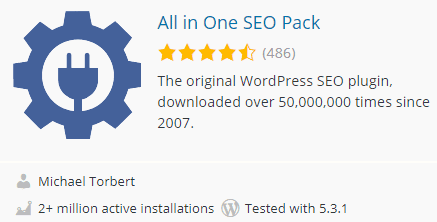
To activate the sitemap in All in One SEO Pack, you will first have to activate the SEO plugin. Once the SEO plugin is enabled, click on plugin > features manager > Sitemap > Activate Sitemap.
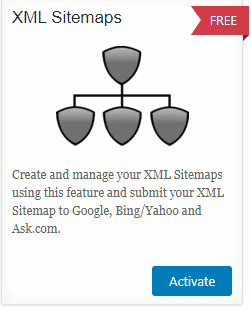
When you activate the sitemap option, it will automatically create a sitemap and enable it. You can test the sitemap with the '/sitemap.xml' URL in the browser.
Source: All in One SEO plugin
The Google XML Sitemap option is for those who do not want an on-page SEO plugin but still want a sitemap. The Google XML Sitemap plugin has over 2 million active users. The advantage of this plugin is that it doesn't take much space, and the options are pretty self-explanatory. Even for a newbie who doesn't know how to handle technical queries, the Google XML sitemap is a no-brainer.
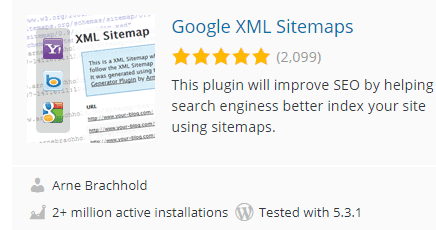
To enable the Google XML Sitemap plugin, go to your Site Settings, click on XML Sitemaps > enable it.
It lets you generate sitemaps for Pages, Posts, Categories, etc. You can also change the priority for posts and pages so that they get indexed faster. It can generate both HTML and XML sitemaps for your website. Once the sitemap is enabled, check it by adding '/sitemap.xml' at the end of your site URL in the browser.
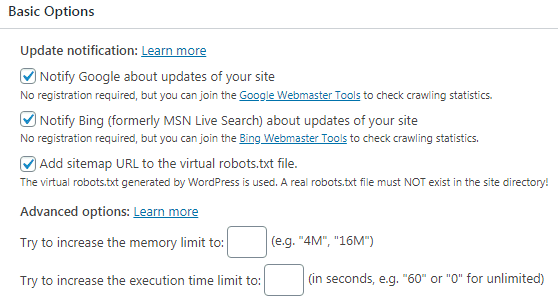
The Better WordPress Sitemap plugin is another great plugin to index websites faster. It lets users index media, posts, and pages. Users will not be limited to only 50,000 XML links in the sitemaps - which this plugin had imposed previously. They can generate as many sitemaps as they want and of as many links as they want.
It is entirely automatic. You don't have to manually index each link as it can be indexed automatically whenever a new post is published. The best part about the Better WordPress plugin is that you can use it to index posts, pages, and even ping Google News and other search engines through your sitemaps.
It has over 40,000 active installs and is considered one of the simplest XML sitemap plugins in the market.

Rank Math is considered as the 'swiss army knife' of the SEO industry. It is just like Yoast and All in One SEO plugins and offers all the functionalities of an on-page SEO plugin. But you can also use it to create sitemaps for your website. Rank Math has over 200,000 active installations. This means it is a well-sought plugin in the SEO community.
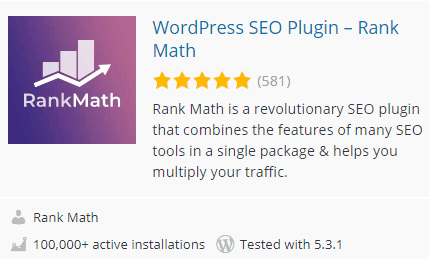
A few reasons to use Rank Math SEO plugin over others in the list is because of the wide variety of features it offers. You can generate an XML Sitemap, or you can also add rich snippet functionality to your posts, pages, images, videos, and or other elements. It also lets you show all these elements in the sitemap separately.
Moreover, you can also generate different sitemaps for Product, Pages, Posts, Categories, Tags, Forum, and more. It is one of the best plugins to use for WordPress based websites and blogs.
WP Sitemap Plugin lets you build an XML sitemap for your WordPress website with the click of a button. It is a great plugin for anyone who is just looking to generate sitemaps for their websites and nothing else. This plugin gets the job done. You can generate sitemaps of media, posts, and pages. It also offers video, products, categories, forums, and much more in the paid section of the plugin. It has over 200,000 active installs and is growing.
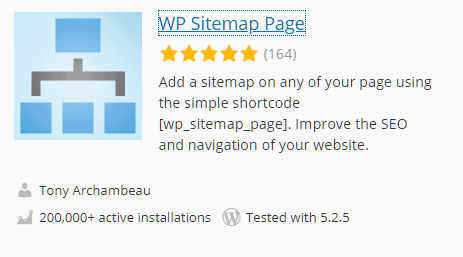
With the WP Sitemap plugin, there are no limits. You can generate as many sitemaps as you want. You can also see the crawl and sitemap statistics right through the plugin options. It won’t create XML sitemaps. It can only generate HTML sitemaps for your website.
Yes, all these plugins offer dynamic sitemaps that automatically add new URLs after they are published on your blog. You don’t have to monitor them actively.
You need only one sitemap for your website. The sitemap should include pages, posts, and other media. All of the above plugins let you do that.
A sitemap should include all the information available on your website. This includes posts, pages, categories, media, forums, products, and anything else that you want search engines to index.
Both works. Most use XML sitemaps specifically for search engines and HTML sitemaps for visitors. But Google doesn’t have any strict policies that only XML sitemaps should be submitted.
Sitemaps are an essential part of any website because it let's search engines find your content. If they can’t find your site content, it won’t rank higher in search engines. All of the WordPress sitemap plugins we mentioned above are perfect for anyone who would like to generate sitemaps for their posts, pages, media, and other forms of online content.
These WordPress sitemap plugins let you index websites faster in search engines and get more organic traffic by ranking the indexed pages for relevant keywords.
—
Thrive Design is a customer-centric web design and development agency from Seattle. Contact us today to find out how we can elevate your business online! Find us on Clutch, UpCity, LinkedIn, Facebook, and Twitter.
In today's segmented world, it seems like there are more and more companies offering one, specific service they claim will revolutionize your business. SEO, graphic design, web design, content writers are all out there ready and waiting to help you take your business to the next level.
The problem is that, at some point, you will find yourself working with three or four different businesses all trying to optimize your website.
Will they work well together? How many times will their wires get crossed? And how will your website suffer as a result?
A web design agency that practices the principles of SEO web design can eliminate all of that trouble and the hassle that comes with wrangling different vendors and agencies.
SEO web design refers to designing and developing SEO-friendly websites. This means designing your website using SEO best practices, not designing a website, and then applying SEO on top of the existing site.

Despite what many people seem to believe, SEO and web design need to go hand in hand. You can't do one well if you are not paying attention to the other.
When your site is designed with these principles in mind, you are guaranteed to keep your customers, and search engines, happy.

Search engines, especially Google, want to keep their users happy by suggesting the best websites for their search queries. One of the ways that Google measures how happy users are with your site, also known as user engagement, is by measuring the average time spent on your page.
Good design, and good content, are vital to ensuring a positive user experience. Traditional web design firms only really concern themselves with the first part of that equation. A web designer that is also fluent in SEO principles will design your business a website that ensures an overall positive user experience, not just one that looks pretty.

Backlinking and interlinking refer to ways that links are used to direct users to your content.
Backlinking is when links to your website and content are featured on other websites and articles. This shows search engines that people view your website as a source of credible information. A good digital marketing strategy can help increase the number of backlinks to your site.
There are several ways to increase the number of backlinks to your site. You can partner with other local businesses to have them link to your site and, in return, you link to their site. You can partner with influencers in your field. You can also do a simple search for people that are writing about your field and pitch them your content to see if they will link out to your content.
This is an SEO strategy that can take some time to build. Interlinking, however, is an SEO strategy that can be built in from day one, if you have a web designer that knows how.
Interlinking is ensuring that your website's content includes links to other parts of your website with content that users interested in that topic may find helpful.
There are a few reasons that interlinking is important in your web design.
For example, on our last blog on the importance of copywriting, we linked to our copywriting services page. That signals to search engines, and users, that these two topics are linked and helps guide visitors towards services they could be interested in.
![web design [suburb]](https://thrive.design/wp-content/uploads/2021/01/web-design.jpg)
If you currently have a content marketing plan, odds are you know the importance of encouraging social sharing. Even if you don't have a content marketing plan, you probably know how important it is to have your site shared on social media sites.
There are definitely instances where social links and shared content on social media sites have shown up before the official website in searches because those links can be more relevant to specific searches.
Web designers that know their SEO stuff know that it's important to include social sharing links prominently and consistently throughout your website in order to encourage this kind of sharing. You want to ensure that these sharing buttons are not just on your blog posts, but also on landing pages, lead magnets, and any other content that you want to be shared.

I love talking about website speed. Having a website that loads as quickly as possible is the best thing you can do to ensure your visitors have the best experience possible. A fast website is also a crucial element in SEO success.
Web design is ultimately what dictates your site's speed. Some designs just load faster than others. A design that's loaded down with unnecessary JavaScript will load slower than one that's not. Images that are optimized will load faster than those that are not.
Web designers that understand the importance of speed in SEO are more likely to make design decisions that will ensure a speedy experience for your visitors.

Navigation is another area of site design that pairs SEO and web design principles. An intuitive navigation setup is a key element to both a usable website design and SEO success.
Simply put, the easier it is to navigate your site to find the information needed, the longer a visitor will stay on your website. The longer a visitor stays on your website, the better your SEO rankings since time on site is a key ranking factor for Google and other search engines.
In 2021, we are all well aware of how interconnected things are, especially online. Web designers should be no exception to this rule. Knowledge of SEO principles and techniques applied to established web design principles and techniques can take a good website to a great website. You and your business deserve nothing less.
—
Thrive Design is a customer-centric web design and marketing agency from Seattle. Contact us today to find out how we can elevate your business online! Find us on Clutch, UpCity, LinkedIn, Facebook, and Twitter.
If you clicked on this article, odds are good that you need a new website or, at the very least, a redesigned website. Your website should be easy to maintain and update and do more work than you at bringing in new business. If it's not meeting these two, basic requirements of a business website, then you have some work to do.
That said, it can be hard to pull the trigger on a potentially-expensive and lengthy redesign process based on just your gut feeling. To help you in your decision-making process, here is a list of seven, easy-to-measure signs that your website needs to be updated.
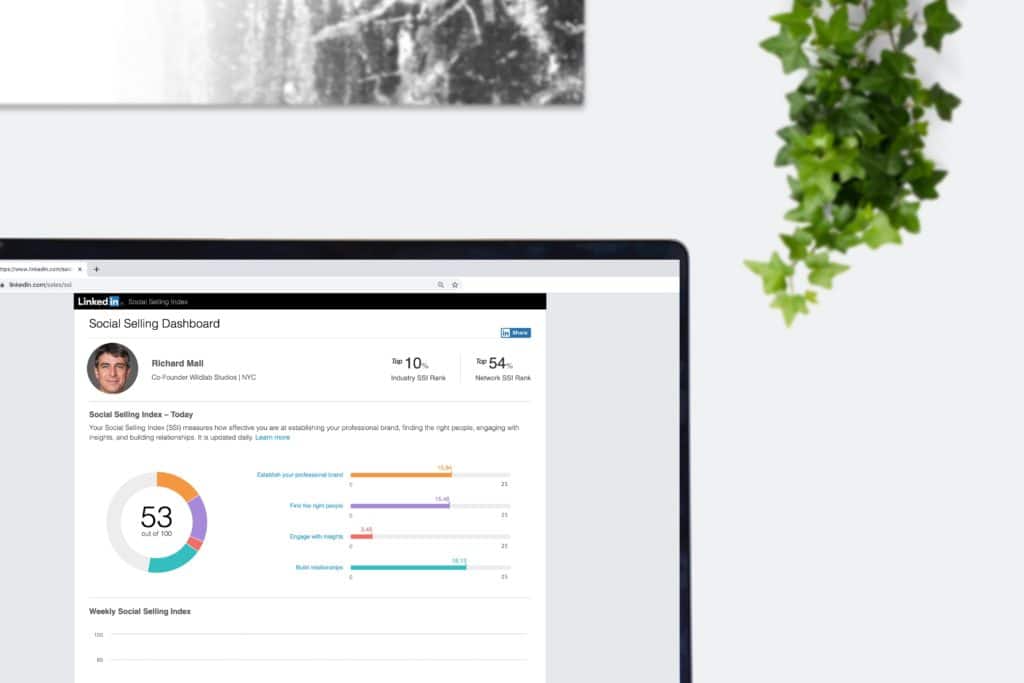
There are seven questions you can ask yourself about your current website to easily figure out if it's time for a new website or an in-depth redesign. These questions should be easy to answer and will give you a good starting place if you decide it's time for a redesign.

Your conversion rate is the measurement of how many potential customers that come to your website turn into actual customers. A website that ranks well and brings in lots of leads is great but if those leads aren't turning into customers, your website isn't doing its job.
A low conversion rate can be a sign that visitors don't find your website helpful in solving the problem they need help solving. Your website should be designed with your target audience in mind. It should be designed so they can find the answers to their questions quickly and easily.
Strategically placed calls-to-action and opt-ins above and below the fold help increase conversions and strategically optimizing for important long-tail keywords will help you attract clients who are ready to buy. Your website design should help your conversion rate not hinder it.

Another sign that your website isn't meeting the needs of your customers is a sky-high bounce rate. A high bounce rate shows that your customers are coming to your page, not finding what they need, and immediately leaving. Google Analytics will show you this statistic right on your search console.
You want your bounce rate to be below 40%. A bounce rate between 40-55% is generally ok; there's some room for improvement but you're not in real trouble. A bounce rate above 55% shows real room for improvement for your website.

Featured Reading: Why is Web Design Important
If your website is not mobile responsive, it is definitely time for a redesign. Having a website that is mobile-friendly is no longer optional. Search engines, led by Google, are now basing search rankings in part on whether a site is mobile responsive. Your site's search engine optimization is now partly based on whether your site is mobile-friendly.
Additionally, mobile website traffic makes up more than half of web visits. If your site isn't compatible with mobile devices, you're missing out on all those potential visitors. Your visitors expect the same user experience from your website, no matter what device they use to access it.
Let's take a look at some more numbers.
A redesign that incorporates the principles of responsive web design is a good move to improve your SEO, as well as your conversion rate and user experience.
Related reading: SEO Seattle

Did you know that 47% of consumers expect your site to load in less than 2 seconds and that 40% of those will leave if it takes more than 3 seconds to load? That's a lot of potential traffic you could be missing out on if your site is a slow loader.
Older sites tend to have graphics and images that are not optimized for a speedy loading experience. Users want what they want when they want it. They aren't going to hang around for all those graphics and images to load.
Long load times will also impact your site's search engine optimization. Google and other search engines prioritize load speeds when determining your search ranking.
Google started using site speed as a ranking signal in their algorithm in 2010. Google doubled down on the importance of page speed in 2018 by starting to use mobile page speed as a ranking in their mobile search results. Page speed will become even more important next year as Google has announced they will be implementing an update that will start judging web pages based on on-page experience, including page speed.
If you want to see how your website's speed measures up, check out Google's PageSpeed Insights. This will give you a good idea about whether you need a redesign before the 2021 updates go live.
Featured Reading: Top 10 Reasons Your WordPress Website is Loading Slow

Nothing in life is forever, including your business and industry. Your website needs to evolve with your brand, products, and messaging. Your website needs to align with your message and the best practices in your industry. This is especially true if you have gone through a rebranding since your current site went live. Any good rebranding should have included an updated website but sometimes things fall through the cracks.
Your website needs to support the rest of your business. In the time since your last redesign, services may have come and gone. Your focus may have shifted from a product-based business to a consultant-based business, or vice versa. If your website doesn't reflect the changes made to your brand's services, look, and feel, you risk losing customers who get confused.
Even if nothing substantial about your business has changed, your website objectives may have changed. You may have started with an informational website designed to answer visitor questions but is that what you still need? Do you want a site that has e-commerce capabilities? Or one that allows your visitors to schedule appointments?
If your priorities and objectives have changed, your website needs to change as well.

Content management is a big part of a functional website. If your website isn't built with a user-friendly content management system, then your website is probably costing you money to make even the simplest of content updates. Adding blog posts shouldn't require a phone call or email.
Your content marketing strategy relies on your ability to update your website regularly. If you have to rely on a web developer or outside third party for content updates, your website is costing you time and money when it doesn't have to.
A website built on a content management system, such as WordPress, allows you and your staff to quickly and easily make updates as needed.

Just like fashion and home design, web design is defined by trends. Your website may not be bad, per se, but there's a good possibility it looks outdated if it has been more than three to five years since your last redesign.
If you're not a tech person and can't tell or don't care what looks or feels outdated, a good way to check is to look at your competitors' websites. Are they markedly different from yours? If they are, there's a good chance that your website is outdated.
Another reason to prioritize the look and feel of your website is that web users want to look at content that is beautifully designed and it impacts what they think about a business overall. When asked what their number one factor was in deciding the credibility of a business is, 48% said it was the website's design.
If you don't find your website nice to look at, then neither does anyone else. You need a website that is engaging, pleasing to the eye, and puts your brand's best foot forward. Remember, your website is your prospects' first impression and you want to make sure it's a good one.
Featured Reading: 10 Examples of Ugly Websites and How We Would Fix Them
Your website is the digital front door for your business. As more and more consumers are turning to the web to find places to shop locally, it's vital that your website is designed to answer their questions and keep them around long enough to convert them to customers. A website redesign or re-do could be just the thing you need if your website isn't converting customers like it used to.
—
Thrive Design is a customer-centric web design and development company from Seattle. Contact us today to find out how we can elevate your business online! Find us on Clutch, UpCity, LinkedIn, Facebook, and Twitter.
Category: Web design seattle
Category: SEO Seattle
Search engine optimization, or SEO, is one of the most effective ways to get your business found online. When done well, SEO can get your WordPress website on the all-important first page of Google, and other search engines, for the search terms that lead to revenue for you and your business.
But implementing a good SEO strategy can be tricky. There's a reason there are so many companies that offer just WordPress SEO services. If you don't have the budget for that, or just prefer a DIY approach, here are ten things you can do to make sure your SEO strategy is as effective as possible.

So where do you start with establishing a strong and effective SEO strategy? Search engines are constantly tweaking the ways that they assign rankings so it can be hard to figure out how to keep on top of the changes. Not to worry. There are some basic things you can do to show your website's strength to search engines.
These 10 steps will help put you and your WordPress website on the path to SEO success.
The first step in any good plan is to articulate where you are and where you want to go. Start with an analysis of your website, your business, and your services or products. Look for what is working in these categories, and what can be improved with better SEO.
Remember, increasing your search rankings is only part of the picture. Setting other goals, whether it's building a customer database, getting more bookings, or increasing sales, is crucial for an SEO campaign that results in meaningful actions for your business.
Featured Reading: Local SEO is Crucial for Service-Based Companies
Identify other local businesses that are offering the same services as you. They are your competition for Google search position. Looking at the marketing strategies they are implementing can give you direction or inspiration on the elements you could include in your strategy as well as highlighting anything you are missing.
Here are some questions to ask in your analysis:
Keyword research is one of the most important steps in SEO. To optimize your WordPress website for search you need to know what your customers are searching for. Google's Keyword Planner tool allows you to enter keywords related to your business and see what volume of monthly searches they generate in your location which is a good way to gauge their popularity. Google Keyword Planner also offers suggestions of related search terms to help you identify opportunities you may not have thought of yourself.

Now that you've selected the keywords you want to target, look at the structure of your WordPress website pages and the content on them. You'll want to aim to have one page for each of your major keywords with 500+ words of good quality content. Don't forget to consider the structure of your page – breaking up content with relevant subheadings and including images can help your SEO when done correctly.
One part of your website to pay close attention to is your blog. Blog posts are prime opportunities for boosting your SEO, especially when it comes to specific keywords. You can create and structure your blog posts to target specific keywords that are hard to target in other parts of your website.
Once you've made sure you have relevant pages and content on your site, it's time to start implementing your on-page SEO. Use the primary keyword for each page strategically in your meta titles, descriptions, page headings and subheadings, URL, image optimization, and page content. Use variations on your keyword to avoid being repetitive and remember, search engines like Google is looking for readability so don't stuff keywords in excessively or out of context.
A backlink is simply a link from another website back to yours. Backlinks act as a referral source, letting Google and other search engines know that your WordPress website is a trustworthy resource, but the quality of the link source is also important. Look for link opportunities from other websites in your industry, association profiles, businesses in your local area, and relevant directory listings.
One great place to start building backlinks is through your Google My Business profile. Google My Business is a great place to solicit ratings and reviews, and to also link back to your website.
Google now analyses websites based on mobile-first indexing, meaning mobile-responsive design is more important than ever. If your website doesn't perform well on mobile, you're also likely to lose customers who are trying to visit your page on their phones so updating your website to be functional across a range of devices is a win-win situation. There are some great mobile-friendly themes available on WordPress so you don't have to do the development yourself.
Featured Reading: Your Website has 15-30 Seconds to Impress
Page speed is an important factor in your rankings, Google ranks faster pages higher, but also impacts other important metrics such as the bounce rate of your site (users who leave without interacting with your site) and time spent on site, both of which also impact your organic position.
Data suggests that 53% of users will leave a page if it takes more than 3 seconds to load and 50% expect it to load in 2 seconds or less. This is especially true for consumers searching on their mobile device Running a report using a free tool such as GTMetrix will provide you with a report on your current website performance and provide suggestions on how to improve it.
One easy place to start is ensuring that your website's images are all of the optimum size. Images that are too large will slow down your website's speed. By strategically sizing down your images, your customers won't notice anything except a website that loads faster.

To know how effective your SEO is, you'll need a clear way to track its performance. Remember those goals you identified in step 1? Make sure you have a method in place to collect data around these, whether it's appointment booking numbers, sales figures, or signups.
It's also a good idea to track general analytics data around your website and SEO performance. Tools like Google Analytics can track your organic traffic and goal conversions, while a good rank tracking tool can help you see the changes in your search results position for your chosen keywords.
SEO is a living process. For it to work well, it cannot be a case of set and forget. You should be consistently reviewing your data, revisiting competitor analysis, refreshing your keyword data, updating your content, building backlinks, and adapting to Google algorithm changes to keep your SEO efforts relevant and up to date.
There are many places in the backend of your website where you can beef up your website's SEO. On each page of your website, you can optimize the image description, title tags, meta descriptions, meta tags, H1 headings, and page names. Search engines crawl each of these elements to determine your site's ranking and, the great thing is, most are invisible to your site's visitors.
Search engines are the best friend and worst enemy of the small business website. They can bring you more traffic than you can handle and, sometimes, they also can seem to overlook you for no apparent reason. That's where tweaking your WordPress SEO can help.
However, if it seems like doing SEO right is a lot of work, you're right. It is. But it's also work that is worth it to your business's bottom line. We get it and we've expanded our services to help.
Our new SEO service will help you realize all the benefits of a professionally crafted SEO strategy, without all of the work involved. (We know how to get you on page one of Google and keep you there.)
A strong SEO strategy is the best way to bring a steady stream of new traffic directly to your digital front door. The long-term results you achieve from an SEO strategy cannot be replicated. Our SEO experts can help create a custom campaign that will deliver the results you need to take your business to the next level.
—
Thrive Design is a customer-centric web design and marketing company from Seattle. Contact us today to find out how we can elevate your business online! Find us on Clutch, UpCity, LinkedIn, Facebook, and Twitter.
The number one way to build trust online is through a robust suite of reviews. Not certifications. Not a slick website. Not even a service guarantee. (Although all those things do help.)
Reviews.
Reviews are the first thing that online consumers turn to when making purchasing decisions. They’re the first thing people see when they Google your business. They’re one of the first things people look for when they come to your website with the intent to purchase.
If you don’t have any reviews, you are missing out on a golden opportunity to grow your business.

I can hear the internal groan and the question that probably immediately popped in your head:
“But how do I get reviews?”
Here’s the revolutionary secret to getting your customers to leave a review: Ask them.
That’s it! It’s that simple.
One reason that consumers are unlikely to leave reviews, especially if they’re satisfied with the service or product, is they don’t think about it. Their experience was so smooth that it blended seamlessly into their daily life and they didn’t need to think about it anymore.
(This is why there’s a stereotype that the only people who leave reviews are dissatisfied. If someone is dissatisfied with a product or service, they tend to fixate on it until they feel they have done something to rectify the situation, usually leaving a review to let other potential customers know about their experience.)
Whether you have 1000 new customers each week or you work with just 1 customer each month, you need to have a streamlined process in place where you are asking your customers for a review after you have delivered your product or service.
Featured Reading: Local SEO is Crucial for Service-Based Companies
Featured Reading: SEO Seattle

The more specific you can be and the easier you can make your ask, the more likely it is that your customers will help you out. So, before you start mass emailing your previous clients, think about exactly what kind of review you want them to leave.
If you want them to leave you a review on Google, Amazon, Trustpilot, Yelp, Angie’s List, or any other specific platform, be sure to include that in your ask along with a link to the exact page you want them to use for their review. The easier you make it for them, the more likely it is they will do what you want them to.
Also, let’s pause real quick and review the term “mass emailing.” Yes, you will be emailing your previous clients but there are good ways AND bad ways to do that.
If you only have a few clients, it’s best to email them individually to ask them to leave a review. The message can be the same but you’re most likely to get a yes from people who feel you reached out personally. A BCC email is not personal.
If you have lots of clients, automation is the way you want to go. The process of automation is actually quite simple.
What you would need to do here is to create an email sequence that consists of one or more emails that are asking your customer to leave a review. You add the customer into your automation sequence and send out an email (or series of emails) asking them to leave you a review. If you already use an email provider such as ActiveCampaign, ConvertKit, Drip, MailerLite, or MailChimp, you should have automation functionality available to you already.

Now that you’ve asked your previous clients for reviews and they’re rolling in, you may think your job is done. But it’s not done quite yet. There are still a few things you need to do.
Say thank you/respond to reviews. One action that truly goes a long way is saying thank you to your customers for their reviews. It can be as easy as responding to the positive review with a simple “thank you!” This also looks good to potential customers who are reading the reviews.
It’s also important to respond to the less stellar reviews. Not only does it address that client’s specific problems or issues, but it also shows that you are a business that cares about everyone’s experience, not just the good ones.
Plan for repurposing the reviews. The answer here is yes. You’ll want to be able to take these reviews and use them on your website, as social media posts, or in other promotional material. Best practice for repurposing reviews is to ask the poster whether or not you can use their review in other ways.
Never incentivize your reviews. Ok so this isn’t something you need to do after asking for reviews, but it is something you need to avoid doing throughout this whole process. While it is acceptable to hold a drawing or raffle for customers who leave reviews, you get into ethically murky waters if you offer something in exchange for a review.
Featured Reading: Looking for More Business? Check Out Your Online Reputation.
Great reviews can massively enhance the reputation of your business and help potential new customers trust that you’re able to assist them with their needs. Whether you sell products or services, it’s important that you’re encouraging your customers to leave reviews. These will show the quality of what you have to offer and in many cases, make a difference in how your business
is viewed in the search engines.
Check out the other steps to creating a website that dominates online with our Blueprint for Online Excellence.
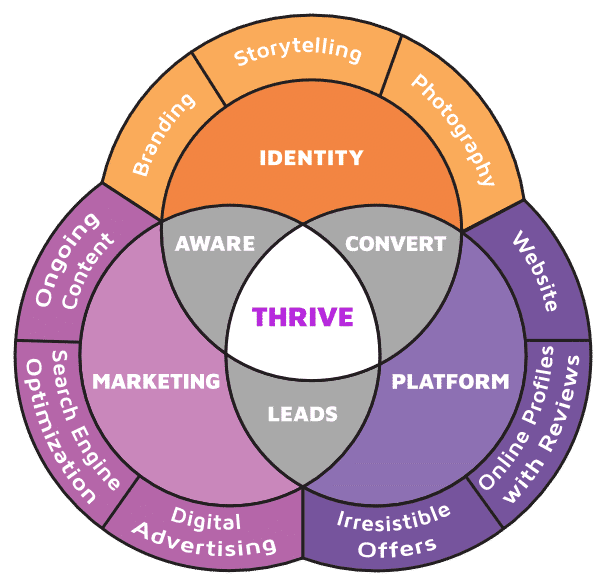
—
Thrive Design is a customer-centric web design and marketing agency from Seattle. Contact us today to find out how we can elevate your business online! Find us on Clutch, UpCity, LinkedIn, Facebook, and Twitter.
To paraphrase Madonna, we are living in a digital world. If you are not experimenting with different digital marketing mixes, you probably aren’t reaching all your potential customers.
If you are serious about remixing your digital marketing mix, take a look at these 12 strategies. You may recognize some of them but now is the time to consider which ones could be helpful to your business as the world becomes ever more digital.

Let’s be honest. Twelve seems like a lot of strategies for a “best of the best” list. Most of these lists have five suggestions, 10 at the most.
But hear us out. Not every digital marketing strategy will work for every business. If we only gave you five or even 10 choices, you may not find the best fit for your business.
So without further ado, here are our choices for digital marketing strategies for 2020 and beyond.
This is the hottest trend in marketing. Video is attracting more and more users every day and has become the preferred way for mobile users to engage with content. If you want to add video to your marketing mix, keep your videos short, and keep them engaging. Video series work great for this. One idea is to break a case study up into small chunks with a cliffhanger at the end of each segment. If you want to see how we do video, check out our YouTube channel.
SEO is still one of the most important marketing strategies to have in your digital mix. An SEO expert can help you master this strategy as it is a hard one to master on your own. One thing to know in this area is that Google is changing its security requirements for pages, and those that aren’t in compliance will not be ranked as highly. They are now asking that websites that ask for contact information carry an HTTPS format, which is more secure than the traditional HTTP.
Related reading: SEO Seattle
SEM stands for Search Engine Marketing. You may also know it as “pay-per-click.” This is another area where an expert can help you dial in the best strategy for your business. If you don’t have the budget for an expert, Google AdWords and FacebookAds have great tutorials and analytics dashboards that can help you learn the basics and experiment as you go.

One of my favorite statistics about local SEO is that 78% of mobile users who conduct a local search on their phone end up purchasing from a physical location. 18% of those users conduct that purchase within 24 hours. A good local SEO strategy is a great way to increase foot traffic and attract more local customers.
Featured Reading: Local SEO is Crucial for Service-Based Companies
Creating landing pages is a great digital marketing strategy, but it only stays a great digital marketing strategy if you keep them updated and optimized. It’s important to monitor activity on your landing pages just like you do on your main site. That way you’ll know when and what needs to be tweaked to bring you better results.
We’re all on Facebook. Lots of us are on Instagram and LinkedIn. There are so many opportunities for you when you embrace a social media marketing strategy. This strategy is a great way to engage with your audience and build a loyal following. However, it will only work if you are committed to posting engaging content regularly. There are lots of great automation tools that can help you accomplish just that. (More on that later.)

Email marketing is a great addition to any digital marketing strategy. It’s great for repurposing content, offering clients exclusive deals, and integrating your other marketing efforts. You can also do it for free, or for a very low cost using third-party platforms. If you are collecting emails on your website, be sure you are using an HTTPS form. (See Strategy #2: SEO.)
The goal of this strategy is to establish yourself as an expert in your field and be a go-to resource for your clients looking for information. A content marketing strategy is a great complement to an SEO strategy as search engines love websites that have regularly updated content that is reliable and valuable to searchers. You are also able to repurpose this content into lots of other forms including emails and videos.
Influencer marketing is working with influencers in your field to promote your product or service. Most influencers will require a fee for this promotion, although some will do it just for a free product. It’s important to note that we’re not talking about Kim Kardashian level influencers here. There are lots of influencers who are not celebrities but who have a lot of, well, influence over their audience. To find the right influencer for your product or service, search the hashtags related to your field and see who your audience is following and listening to.

Just because someone leaves your website without taking action doesn’t mean they aren’t interested in doing business with you in the future. Remarketing, or retargeting, ensures that your business ads stay in front of their eyes on other websites. This keeps you at top of mind and raises the probability that they return to you for their final purchase.
While this is less of a marketing strategy than a web design best practice, it’s key to ensuring the success of your other marketing efforts. The majority of consumers are visiting websites on their mobile devices. If your site isn’t able to be viewed, or is hard to navigate, from these devices, you will lose customers faster than you think.
Featured Reading: What Does Responsive Web Design Mean?
Everything from your email to your social media marketing efforts can be automated with amazing effectiveness. Finding which of your marketing practices can be automated, and then automating them, will save you time and money, while also increasing your marketing efficacy.
Don’t feel overwhelmed. You don’t have to immediately implement all 12 of these strategies to see a return. These are just suggestions for strategies you can add to your digital marketing mix to kick everything up a notch. However, it is important that you are regularly updating your marketing strategy to find the best combination for your business.
—
Thrive Design is a customer-centric web design and marketing agency from Seattle. Contact us today to find out how we can elevate your business online! Find us on Clutch, UpCity, LinkedIn, Facebook, and Twitter.
“If you build it, they will come” does not work with your website. If you don’t tend to these six areas on a regular basis, you risk losing valuable business for your company.

Two words: Responsive Design.
The average business website will get 40% - 50% of traffic from users on mobile and tablet devices. This number can be as high as 80% for some industries.
If your website isn’t designed so that it displays well no matter what device your visitors are using, you’re missing out on some business.
Two more words: Updated Design.
Trends in design aren’t limited to fashion and home goods. They apply to websites as well. A trendy element that you added to your site in 2010 may not read as well to 2020 consumers.
Just like you wouldn’t trust an interior designer whose portfolio looks like it was last updated in 1995, your customers aren’t going to appreciate a website with outdated design.
Consumers want a website experience that is easy and intuitive. If your site doesn’t provide that for them, they will look elsewhere.
There’s an easy way to check to see if your website is set up for the best user experience. If you can answer “yes” to the following four questions, you’re probably in good shape. If you can’t, you know where to start to create a better user experience.

If your website doesn’t show up on the first page of Google, does anyone care? Unlike the tree falling in the woods, people do.
When your business shows up on the first page, or ideally in the first few results, you have far more chance of someone who is searching for a business like yours, clicking through to your website.
Again, there is an easy way to check the strength of your search engine visibility: go to Google and search for the keywords associated with your business and see where you show up.
Be creative with your search terms. Add in your location and surrounding cities. Use abbreviations. All of these are opportunities for finding new clients and customers.
Related reading: SEO Seattle
Conversion optimization is the process of figuring out how many of your website visitors are taking the action you want them to at the end of their visit.
Here’s the straight-forward formula used to calculate the conversion rate of your website: Conversion Rate = [Action Number] / [Visitor Number] * 100.
If that number isn’t what you want or need it to be, there are a few, simple things that you can tweak to bring it up.

Faster websites are better websites. Slow websites result in frustrated visitors and lower search rankings. Fast websites lead to happy visitors and higher search rankings.
And how fast is fast? Your site should load in no more than two (2) seconds.
Fast websites build trust with your visitors. They keep visitors engaged with your content. They help visitors understand what you do, better.
If you’re concerned about the speed at which your website loads, there are some things you can do to up your website’s load speed.
Your website visitors are looking for a website they can trust. One that will be there when they need it. One that is secure and reliable.
For that reason, you need to be considering website security as a top issue when thinking about how to run a successful website.
Just because you run a small- to medium-sized business, doesn’t mean you’re NOT a target for hackers or other cybercriminals. Much cybercrime these days isn’t about stealing data. It is focused on using your website to send out spam emails or embed malicious elements to make another website look better.
Keeping your website updated, fresh, and secure is the best way to ensure that you are getting, and keeping, new and repeat business. These six elements are a great place to start to ensure you are doing just that.
—
Thrive Design is a customer-centric web design agency from Seattle. Contact us today to find out how we can elevate your business online! Find us on Clutch, UpCity, LinkedIn, Facebook, and Twitter.
Category: Web design seattle
The internet was not made for static websites. If you’re not adjusting your website (and tracking what works), you are just asking for your website to wither and die.

Your website is able to give you all kinds of information if you know where to look. This information can be used to tweak your website to better meet the needs of your website’s visitors.
If you’re wondering where to start collecting website data, the place that most people go is Google Analytics. Google has designed its analytics platform to be one of the most robust analytics platforms available.
From your Google Analytics dashboard, you are able to see at a glance which of your pages have the most visitors, which pages have high bounce rates, which pages earn you the most money, and so much more. You are also able to track where your site visitors are coming from, which is especially helpful when you’re running any sort of marketing campaign.
Google Analytics is also designed to work especially well with Google Ads. (Remember step one?) The Google Analytics platform can give you even deeper insights into how users from your Google Ad campaign have interacted with your site.
As deep of a dive as Google Analytics can give you, sometimes you want something more visual, something that can give you an at-a-glance analysis of what people are clicking on when they visit your website.
We love HotJar for just that reason. We use HotJar to analyze our site on a regular basis. They give you access to three very useful tools for analyzing visitor behavior.

HotJar and Google Analytics are great ways to figure what’s working and what’s not on your website, but it’s pretty hard to test how well website changes are working if you can only see data after the fact.
When you want to test tweaks to copy, navigation, or other parts of your website, what you really want to do is conduct some A/B testing.
It sounds complicated, but it’s really not. What A/B testing does is allows you to present two different website versions: one to 50% of your visitors and one to the other 50%. SplitHero is our tool of choice for running A/B tests.
A/B testing doesn’t have to be complicated. It can be for something as simple as swapping out an image or trying a different header for the page. It could be moving up your signup form or lead generation offer to higher on your homepage.
A/B testing is the perfect way to try out some of the ideas you got from all the amazing insights you learned by tracking your website’s performance and visitor behavior.
If you did it well, you used data about your market and target audience to build your website before you launched it. There is no good reason to stop using data to make the ongoing changes needed to keep your website fresh and relevant so you stay top of mind for your clients and potential customers. These tools, and our help, can take your website game to the next level.
Keep Reading: The Killer Offer: Step 6 of 9 for Dominating Online
—
Thrive Design is a customer-centric web design and development company from Seattle. Contact us today to find out how we can elevate your business online! Find us on Clutch, UpCity, LinkedIn, Facebook, and Twitter.
Category: Web design seattle
As helpful as Google Analytics is, it can be one of the least user-friendly tools in your arsenal. It’s even tricky for some experts to figure out all the ins and outs at first.
Thrive's web design agency has your back. Our step-to-step guide to adding a new website to your Google Analytics will help you ensure that all of your web properties are in one easy-to-access dashboard.

We love a good step-by-step how-to especially if there are pictures involved.
This step is pretty straightforward. Hopefully, you can even skip this step if you visit frequently enough to have your login information stored and ready to go.

In the newest version of the Google Analytics dashboard, the Admin button is somewhat hard to find. It’s slightly buried at the bottom of the left-hand side of your dashboard.
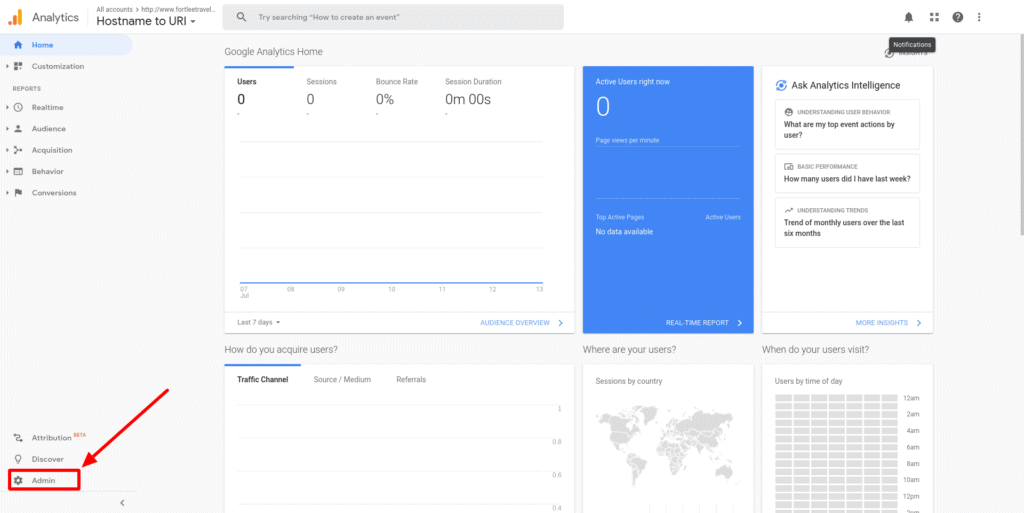
If you need to create a new account, there are a few steps you’ll need to go through to make sure it’s all set up. You’ll need to make some choices about what you want to measure and what data you want to share with Google.
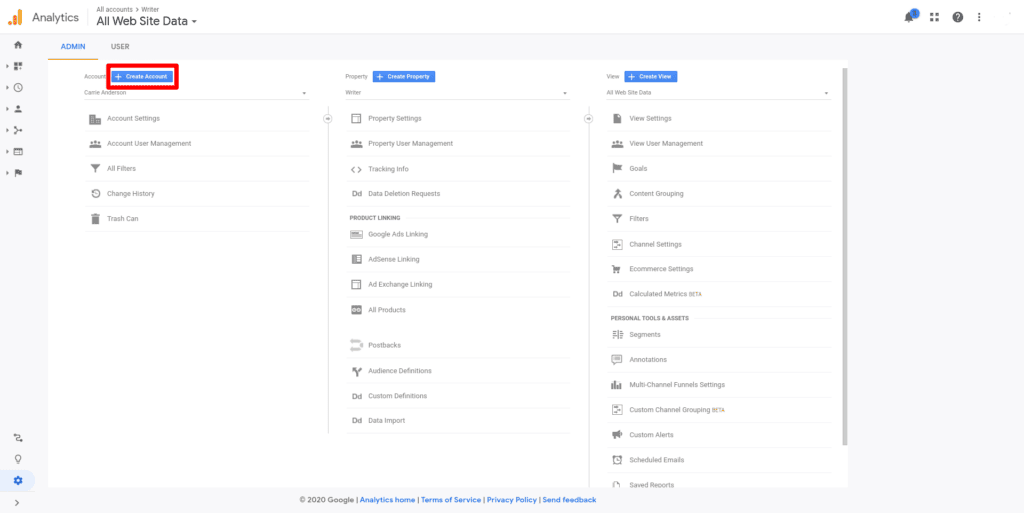
Again, you’ll need to choose what you want to measure: your website, an app, or both. Once you make those choices and add in your web address, you’ll get your analytics tracking code, along with all you’ll need to add the analytics into your website’s code.
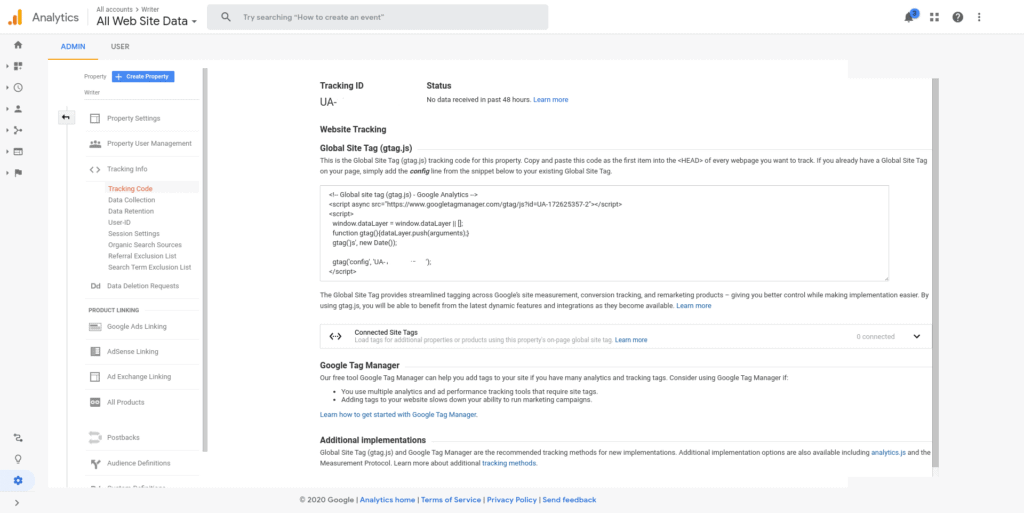
See Related: How Long Does it Take for a Website to Show Up on Google
Data is king. And Google Analytics is the king of data.
When you need information about how websites are performing, Google Analytics is where you should turn for the most accurate, most up-to-date, most robust (and FREE) trove of data. By keeping your GA account updated with all of your webpages, you ensure that you are getting all of the best information you need to keep your website performing at its best.
With Google Analytics you can:
Bonus: The 6 Best CSS Frameworks for 2020
Don’t let the sometimes confusing interface deter you from taking full advantage of all that Google Analytics has to offer. Drop a note in the comments and let us know if you have any more questions or want other Google Analytics step-by-steps.
Keep Reading: How Do You Announce a New Website Launch?
—
Thrive Design is a customer-centric web design and development company from Seattle. Contact us today to find out how we can elevate your business online! Find us on Clutch, UpCity, LinkedIn, Facebook, and Twitter.
Category: Web design seattle
Many marketing pros and small business owners dread facing the Google algorithm, the Internet monster that places websites in its organic search results. If your web designer just finished your new website, and you’re wondering how long it takes for a website to show up on Google, follow these pro tips to turn the monster into a supportive friend.

As you add your new website to the multitude of sites on the web, Googlebot searches through the vast Internet to fetch web pages. The bot is often called a spider, and the bot is crawling around, looking for and fetching the content.
Next, the fetched pages are indexed in Google so that when someone searches with a word or set of words, all web pages that contain those words are pulled up into the results.
Bonus: How Do You Announce a New Website Launch
The Google processes of crawling and indexing can take days or weeks to find your web pages and place them in line for an organic search. You can’t provide a deadline for Google, and you can’t predict with certainty that it will be 5 days or 25 days before you find your site on the results pages.
The good news: Your business is not totally without influence on obtaining results status as you can implement certain practices to help Google to find and index your pages more quickly.

Google can use a bit of help with knowing that your site exists. Knock on the door and asked to be let inside by creating a sitemap, an XML document, and submitting it to the Google Search Console. You can also submit individual pages URLs. Submitting the sitemap says to Google, “Hey, here I am. Feel free to look around.”
A second way to let the Google engine know that you exist is to turn on Google Analytics. It’s will be your tool to analyze your success, but, in this case, it sends a signal to Google that your website exists. Both tactics could speed up the indexing process.
See Related: How Much Does It Cost to Redesign a Website?
Links to your site could be the golden pathway to a quicker Google listing. You might think that you need a listing to get traffic to your site, but it works both ways. Google will notice if your site gets a lot of activity that comes from placing links in your Tweets, Facebook posts, Instagram posts, blog posts, emails, online directories, and on the sites of others who share the excitement about your brand.

No one wants to be on a website that doesn’t have great information, well-written content, and good quality images that are consistent with your brand. Neither does Googlebot!
Use SEO practices, including meta tags and short- and long-tail keywords, and alt text on images to aid the spiders behind the scenes. The spiders find well-designed, good content more easily, making a faster listing a possibility.
Related reading: SEO Seattle
Did you know that poor design can block Google from finding your site? That would be a disaster. Be careful to not leave code in that tells Google to not crawl your site, often used during development.
Fix robots in the coding that, while intended to keep the crawlers out of certain parts of the site, unintentionally block the content you want to be searched and indexed. Also, check your links regularly and make sure they’re unbroken. Keep your design error-free for the best search possibilities.
See Related: The 6 Best CSS Frameworks for 2020
We’re not talking about the famous Whitney Houston song here. How do you know if your site is indexed on Google? Go to the Google search bar and type in site:(yourwebsite.com).
You’ll find out if your site is indexed and how many pages are included. Indexing gives you the first part of the listing equation, although It doesn’t guarantee that you’re listed yet. New sites take time to index and, as you may know, waiting requires a great deal of patience.
The Google algorithm is your friend.
If you do nothing but create a website, don’t expect a quick trip to the search results. It’s worthwhile to put your efforts into the best practices that make your site more easily findable. It turns the Google algorithm monster into a supportive friend that works for you and your website. Once your site is listed in the results, keep up with your efforts to keep your site listed and work on raising your site higher in the rankings for greater visibility.
Keep Reading: How to Move Your Website to a New Host
—
Thrive Design is a customer-centric web design agency from Seattle. Contact us today to find out how we can elevate your business online! Find us on Clutch, UpCity, LinkedIn, Facebook, and Twitter.